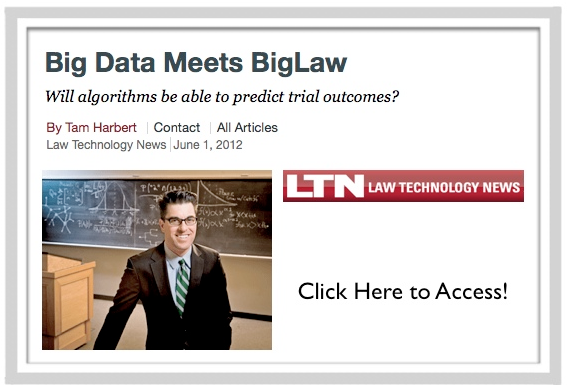Tag: industries
Udacity – The Future of < Online > Education?
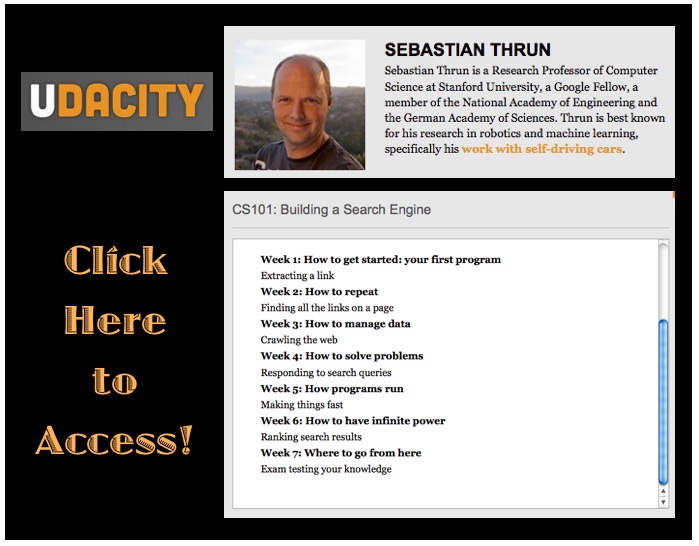 Sebastian Thrun of Stanford AI Class fame (you know – the largest class in human history with 160,000 participants) has just left his tenure track position to start an online education platform – Udacity. Here is an article about Udacity and here is the statement from the website: “We believe university-level education can be both high quality and low cost. Using the economics of the Internet, we’ve connected some of the greatest teachers to hundreds of thousands of students all over the world. ” In other words, the for-profits (i.e. University of Phoenix) as well as all of us at standard four year universities should be scared!
Sebastian Thrun of Stanford AI Class fame (you know – the largest class in human history with 160,000 participants) has just left his tenure track position to start an online education platform – Udacity. Here is an article about Udacity and here is the statement from the website: “We believe university-level education can be both high quality and low cost. Using the economics of the Internet, we’ve connected some of the greatest teachers to hundreds of thousands of students all over the world. ” In other words, the for-profits (i.e. University of Phoenix) as well as all of us at standard four year universities should be scared!
Thoughts on the State of American Legal Education – The New York Times Editorial Edition
(1) The NYT Sort of Gets It – The Market for Legal Services Meets The Market for Legal Education
 I am a bit torn by all of this. In general, I think the NY Times should be commended for its decision to highlight the problems in the legal education market. While I could flag disagreement with some aspects of their coverage, the basic thrust is so true – major reform of American Legal Education is clearly needed. However, what precise reform should be adopted is where the argument really begins.
I am a bit torn by all of this. In general, I think the NY Times should be commended for its decision to highlight the problems in the legal education market. While I could flag disagreement with some aspects of their coverage, the basic thrust is so true – major reform of American Legal Education is clearly needed. However, what precise reform should be adopted is where the argument really begins.
Here is the iron rule of the law school reform business — platitudes abound and specific proposals are few and far between. When I talk to folks in the legal academy about the state of our business – typically, the response is something akin to this “you know Dan – if only we taught more of my subject area – our students would be much better off.” Seriously, the crazy thing is that folks make the subject area superiority claim almost independent of the subject matter they teach (for example – even Con Law profs will sometimes do this). To be fair, I am of course no different in offering my specific reform proposal (but I have the virtue of not entirely engaging in data free speculation).
There was a lots of pushback on the NYT Segal article. Much of it was deserved. However, lets go back to the Segal NYT article for a moment. Ignore some of the areas where he clearly gets it wrong and instead focus on the following proposals for reform:
- A better understanding of modern litigation practice, which is about gathering facts and knowing how to settle a case.
- Greater familiarity with transactions law, including how to draft, evaluate and challenge a contract.
- Deeper knowledge of regulatory law and the ability to respond to a regulatory inquiry or enforcement action.
- Basic corporate legal skills, like how to perform due diligence.
- Writing skills. Partners at law firms say they spend a lot of time improving the writing of their first- and second-year associates.
- A stronger grasp of the evolving economics of legal practice, which will rely less on leveraging the time of new associates and more on entrepreneurship.
It would be hard for me to disagree with any of these (particularly the last one). However, I would add one very large missing element – technology. Where is the discussion of technology? Legal informatics, legal information engineering, the global legal supply chain, soft AI, etc. It is barely mentioned in the Segal article and it is barely mentioned in the NY Times editorial. It is actually the most important thing on the list (because it touches nearly every practice area) and it will define the future of the legal employment market.
(2) Restoring the Value Proposition – The MIT School of Law
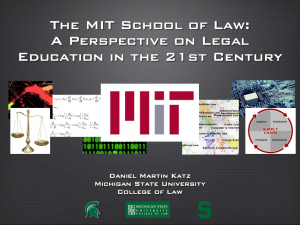 The first step to recovery is admitting that you have a problem. So, it is time for the academy to look in the mirror and admit it – we have a problem. The return on investment (ROI) of a J.D. is waning and reform is needed before the system collapses (via the reform in student loan market). The ROI is not really within the control of any particular institution. What institutions control is the curriculum and it is fair to say that the curriculum offered at most institutions is in need of a serious reboot.
The first step to recovery is admitting that you have a problem. So, it is time for the academy to look in the mirror and admit it – we have a problem. The return on investment (ROI) of a J.D. is waning and reform is needed before the system collapses (via the reform in student loan market). The ROI is not really within the control of any particular institution. What institutions control is the curriculum and it is fair to say that the curriculum offered at most institutions is in need of a serious reboot.
Larry Ribstein has appropriately described the American Legal Academy as a hothouse. I could have not said it better. Indeed, some strange plants have grown in here (with the insulation from market pressures). Those plants could not survive if subjected to a well functioning market for legal education.
Lets just get this out the way right now – there is less humanities in law’s future. I have nothing against the humanities but this is no longer a humanities age (other than this). It is an age of technology. Law school needs to transition from its liberal arts predisposition to a polytechnic research and teaching operation. From both a scholarship and training perspective, it is time to get serious about science, computation, data analytics and technology. I have argued that the arbitrage opportunity in the market for legal education is for an institution(s) the move toward an “MIT School of Law.” An MIT style institution would do just fine in the market for legal education. If you are an employer – hiring a lawyer for the 21st Century – please ask yourself this question: do you want a student from an MIT Style institution or some sort of liberal arts school? Of course, the market will ultimately decide this question — but I would place my bet with MIT.
Lets be clear about one other thing – better training is not likely to create more overall law jobs. If anything the future of law is going to have fewer (and very different lawyers). To better serve our students, we need real competition between schools (instead of blind mimicry of HLS/YLS). The “T14 schools” and the T14 wannabes suffer from the market dominance problem – they are typically too conservative to engage in serious innovation. Other than George Mason (back in the day) there are very few institutions they have played — Moneyball: The Law School Edition. There are notable exceptions but it difficult for those who were rewarded from a particular ordering to then turn around and see the illegitimacy / temporal properites of that ordering.
By the way, other than Michigan Law (where I got my J.D.), I really do not care what these other schools do. If the rest of them what to keep on believing that everything is cool – they can go right ahead. Just please understand that I will use this fact to beat up on them when it comes to recruiting students, etc. It will sort of go like this: “Let me just tell you as plainly as I can — they (some other unnamed school) just does not get it. They are stuck in another world – an analog world. If you go to ______ School of Law you simply are not going to get the quality of forward looking training we can offer here. Please do your research and when you do I think you will see that we are the institution that is ahead of the curve.”
(3) Realistically Positioning Oneself For Future Success in the Market For Legal Services
Students do carry some of the blame here. They are far from realistic about their position in the market for legal services and thus pursue coursework and training for which there is limited (zero) labor market payoffs. This happens at every institution, every year and has been going on for a very long time. I know a number folks at various schools that actually offer really good elective courses. You know – the types of elective courses that would allow students to gain useful skills. Many of them have difficulty filling their classes. The “I did not go to Law School to do Math” pathology runs deep.
Given the cost of tuition and the rapidly declining state of legal employment market – the cost of this myopic behavior has become extremely high. The open question for each institution is how much paternalism they should impose to help students (who are often operating at a serious information deficit) make choices that serve their long term interests?
(4) Note: The English (and Canadian System) Are Actually Under Extreme Pressure
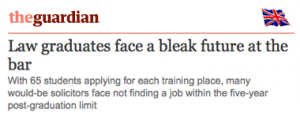 While in general I appreciate the rejoinder offered by Brian Leiter, he is slightly incorrect about the situation in the UK. There is an employment crisis there as well. Indeed, for a glimpse of the problem, please check out this past Friday November 25, 2011 Column “Law Graduates Face a Bleak Future at the Bar” from The Guardian. Actually, it worth noting that a similar crisis exists in Canada — see Law Profession Faces an ‘Articling Crisis’ from The Globe and Mail.
While in general I appreciate the rejoinder offered by Brian Leiter, he is slightly incorrect about the situation in the UK. There is an employment crisis there as well. Indeed, for a glimpse of the problem, please check out this past Friday November 25, 2011 Column “Law Graduates Face a Bleak Future at the Bar” from The Guardian. Actually, it worth noting that a similar crisis exists in Canada — see Law Profession Faces an ‘Articling Crisis’ from The Globe and Mail.
The UK and Canada are in a bad spot (although the regulatory changes in the UK may help them recover quicker). This is not exclusively legal education’s fault as some of this is certainly the recession. The issue is both (1) the recession (hopefully short term) and (2) technology (the long term problem). Law schools should pivot to teach their students to understand the technology infused law business of the 21st Century. Technology is not everything but it is likely over the coming decades to seriously redefine a non-trivial # of the current law jobs .
I am happy to be proven wrong (seriously – it would make my life much easier) but I would argue that the our method of training is in part responsible for the depth of the problem we face. While the use of case method has declined over the past decades, it still holds significant sway over the pedagogy of the modern legal academy.
What is the solution? What is the positive agenda? What a stockbroker tells you is the idea you should carry into this domain – diversification. Since we are in a turbulent period and do not quite know what the future holds, law schools and law students need to diversify their skills offerings — legal training + ( formal logic, supply chain mgmt, economics, project mgmt, data science, computation & info tech, decision theory, legal informatics, etc.) Excessive reliance one form of skill development (i.e. the case method) makes it harder for graduates to pivot when the labor market demand both shrinks and changes (as it has since ~2007). The available evidence indicates a change in demand is in the direction of hybrid skills (skill blending of law and __ variety)
From the NY Times, “Even after the economy recovers, the outsourcing of legal work from law firms and corporate counsel offices to lower-fee operations overseas is likely to continue.” This is true. We have a global legal supply chain and many of the law jobs of the future will involve managing that supply chain and contributing value to that supply chain.
(5) Dear Mr. Segal – It Turns Out that Power Law Distributions Are Ubiquitous
 There is a wide variety of interdisciplinary work in the legal academy – from the über serious to the downright nonsensical. The serious stuff and serious people will ultimately connect what the market values. I stayed out of the Segal NY Times piece largely because I felt that others had offered an adequate response to some of the problems associated with the article. However, I do want to make one important point about the citation distribution that he briefly discusses in the article.
There is a wide variety of interdisciplinary work in the legal academy – from the über serious to the downright nonsensical. The serious stuff and serious people will ultimately connect what the market values. I stayed out of the Segal NY Times piece largely because I felt that others had offered an adequate response to some of the problems associated with the article. However, I do want to make one important point about the citation distribution that he briefly discusses in the article.
Thomas Smith’s 2007 Article “The Web of the Law” is an instant classic. It was way ahead of its time and was probably missed by many law review editors and law professors because it was so novel (see also the math aversion discussion above). Yes, it turns out that citations to law reviews roughly follow a power law distribution (physics folks please do not yell at me – it is power law with a cutoff / extremely skewed / roughly 2< α <3). You know what else follows a power law or other related distribution – tons of things. In turns out, there is absolutely NOTHING unique of the patterns of citation that we observe in law. It is a pattern that is ubiquitous to a wide class of social and physical phenomena. Thus, the idea that many things have not been heavily cited is not a particularly useful point in an argument about the value or non-value of legal scholarship. Please see my discussion of power laws and positive legal theory, etc. in these posts (here) (here) and (here). See also my former Professor Lada Adamic’s tutorial (here).
(6) The Michigan State University Solution – 21st Century Law Practice Program
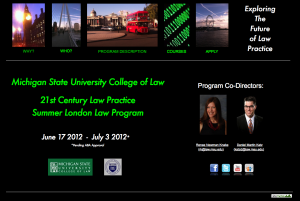 Here at Michigan State University – College of Law we have already begun to pivot. Next semester, I am teaching a version of Quantitative Methods that is infused with information technology, etc. (see discussion here). Summer 2012 we will be offering a summer program called 21st Century Law Practice – London Summer Program.
Here at Michigan State University – College of Law we have already begun to pivot. Next semester, I am teaching a version of Quantitative Methods that is infused with information technology, etc. (see discussion here). Summer 2012 we will be offering a summer program called 21st Century Law Practice – London Summer Program.
Here are the Three Courses for the 2012 Edition:
Legal Information Engineering & Technology
21st Century Law Practice
The Legal Services Act and UK Deregulation
Here is program description: “The MSU/Westminster 21st Century Law Practice London Summer Program is a first of its kind, intensive study of technology, innovation, regulation, entrepreneurship and the international legal marketplace. With the deregulation of lawyers in the United Kingdom and the outgrowth of alternative legal services delivery models, London is poised to become the global leader in the legal services market. Our program will educate students about these new delivery models and help prepare students for the technology infused law jobs of the 21st Century.”
The 21st Century Law Practice program has three main educational objectives:
(1) Provide students a comprehensive understanding of the market for legal services as it transitions to a global legal supply chain in the wake of deregulation, economic pressures, and technological innovation.
(2) Prepare students to become practice-ready entrepreneurial lawyers who can leverage information technology in order to operate more efficiently and to attract (and retain) clients.
(3) Inspire students to think broadly about future delivery of legal representation and access to justice by exposing them to the innovative legal service delivery models and platforms of the present (and not-too-distant future).
(7) Forgive Me Science For I Have Sinned – Bridging the Scientific Legal Scholarship and Law Practice Divide?
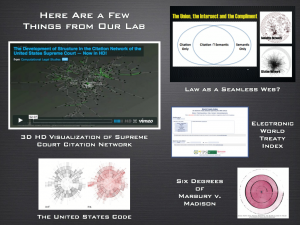 The academic study of law can be a serious scientific exercise — and yeah this science can directly inform modern law practice. Indeed, one of the major goals in starting this blog was to demonstrate this proposition. The lawyer of the future needs to be able to leverage technology to practice law an efficient manner. The science and engineering that is needed is the type that would be pursued at an “MIT Style School of Law.” Tech transfer, legal R&D is one of the things that the law school of the future can do to aid law practice. This (among other things) could help restore some of the value proposition and help foster much needed innovation in the market for legal services.
The academic study of law can be a serious scientific exercise — and yeah this science can directly inform modern law practice. Indeed, one of the major goals in starting this blog was to demonstrate this proposition. The lawyer of the future needs to be able to leverage technology to practice law an efficient manner. The science and engineering that is needed is the type that would be pursued at an “MIT Style School of Law.” Tech transfer, legal R&D is one of the things that the law school of the future can do to aid law practice. This (among other things) could help restore some of the value proposition and help foster much needed innovation in the market for legal services.
What it means to practice law and “think like a lawyer” is not a static proposition.
As Law Schools – we better get to the future — before the future gets to us : )
Estimating U.S. Government Subsidies to Energy Sources (02-08) [From Environmental Law Institute]
Click above to access visual and for the Full Report entitled Estimating U.S. Government Subsidies to Energy Sources: 2002-2008 click here! [HT: Barry Ritholtz @ The Big Picture]
The Evolution of FCC Lobbying Coalitions [Pierre de Vries]
The Journal of Social Structure is currently running an online visualization symposium that I would suggest checking out. Among the broader set of offerings, the readers of this blog might be particularly interested in Pierre de Vries‘ work on the evolution of lobbying coalitions. Anyway, for those who want to learn more about the FCC lobbying project — check out the slide show above!
Cash for Clunkers – Visualization and Analysis
Cash for Clunkers: A Dynamic Map of the Cash Allowance Rebate Systems (CARS)
Some Background on the Car Allowance Rebate System (CARS)
From the official July 27, 2009 press release – “The National Highway Traffic Safety Administration (NHTSA) also released the final eligibility requirements to participate in the program. Under the CARS program, consumers receive a $3,500 or $4,500 discount from a car dealer when they trade in their old vehicle and purchase or lease a new, qualifying vehicle. In order to be eligible for the program, the trade-in passenger vehicle must: be manufactured less than 25 years before the date it is traded in; have a combined city/highway fuel economy of 18 miles per gallon or less; be in drivable condition; and be continuously insured and registered to the same owner for the full year before the trade-in. Transactions must be made between now [July 27, 2009] and November 1, 2009 or until the money runs out.”
On August 6, 2009, Congress extended the program adding $2 billion dollars to the program’s initial allocation. For those interested in background, feel free to read the CNN report on the program extension.
On August 13, 2009, the Secretary offered this press release noting “[T]he Department of Transportation today clarified that consumers who want to purchase new vehicles not yet on dealer lots can still be eligible for the CARS program. Dealers and consumers who have reached a valid purchase and sale agreement on a vehicle already in the production pipeline will be able to work with the manufacturer to receive the documentation needed to qualify for the program.”
On August 20, 2009, the Secretary announced the program would end on August 24, 2009 at 8pm EST. While this remained the deadline for sales, dealers were provided a small extension to file paperwork ( Noon on August 25, 2009). For those interested, all other press releases are available here.
The Cars.gov DataSet
The full data set is available for download here. From the Cars.gov website “these reports contain the transaction level information entered by participating dealers for the 677,081 CARS transactions that were paid or approved for payment as of Friday, October 16, 2009 at 3:00PM EDT for a total of $2,850,162,500. Please note that confidential financial or commercial information and consumer information protected under the DOT privacy policy has been redacted.” The official cars.gov website offers additional caveats on its note to analysts. One important thing to note, there is a statutory exemption which allowed transactions to occur pursuant to an amended rule after the August 24, 2009 termination date. Here is the relevant language of the amended rule:
“To qualify for the exception process, a dealer must have been prevented from submitting an application for reimbursement due to a hardship caused by the agency. Specifically, a dealer may request an exception if the dealer was locked out of the CARS system, contacted NHTSA for a password reset prior to the announced deadline, but did not receive a password reset. A dealer also may request an exception if its timely transaction was rejected by the CARS system due to a duplicate State identification number, trade-in vehicle VIN, or new vehicle VIN that was never used for a submitted CARS transaction, if the dealer contacted NHTSA prior to the announced deadline to resolve the issue but did not receive a resolution. Finally, a dealer may seek an exception if it was prevented from submitting a transaction by the announced deadline due to another hardship attributable to NHTSA’s action or inaction, upon submission of proof and justification satisfactory to the Administrator.”
For those who have downloaded the full set, the above passage explains why there exist transaction data which fall outside of the general CARS program window.
Dynamic Visualization of the Spatial Distribution of Sales
Each time step of the animation represents a day for which there exists data in the CARS official dataset. While the program officially started on July 27, 2009, the dataset contains both transactions undertaken during the pilot program as well as transactions undertaken pursuant the exemption process described above. Thus, the movie begins with the first unit of observation on July 1, 2009 and terminates with the final transaction on October 24, 2009. Similar to a flip book, the movie is generated by threading together each daily time slice.
The Size and Color of Each Circle
Each circle represents a zip code in which one or more participating dealerships is located. The radius of a given circle is function of the number of CARS related sales in a given zip code as of the date in question. In each day, the circle is colored if there is at least one sale in the current period while the circle is resized based upon the number of sales in the given period.
In the later days of the data window, particular those after official August 25 termination of the program, the daily sales are fairly negligible. However, as outlined in the dataset description above, each participating institution who qualified for the exemption was allowed to submit transactions beyond official program termination date. Notice the cumulative percentage of sales reach nearly all total sales by August 25th. Virtually all sales occur during the official July 27, 2009 – August 24, 2009 window. Thus, while these the stragglers caused certain circles to remain illuminated the size of circles is essentially fixed after August 24, 2009.
Some Things to Notice in the Visualization
In the lower left corner of the video, you will notice two charts. The chart on the left tracks the contribution to total sales for the given day. The chart on the right represent the cumulative percentage of sales to date under the program. Not surprisingly, most of the transactions under the CARS program take place between July 27, 2009 – August 24, 2009 time window.
Within this window, the daily sales feature a variety of interesting trends. During each Sunday of the program (i.e. August 2nd, August 9th, August 16th & August 23rd) sales were significantly diminished. Not surprisingly, the end of week and early weekend sales tend to be the strongest.
In the very early days of the program, there were a variety of media reports (e.g. here, here, here) highlighting the quickly dimishing resources under the program. Obviously, it is difficult to determine the underlying demand for the program. However, given the extent of the acceleration, it appears these reports contributed to the rapid depletion of the initial 1 billion dollars allocated under the program. A similar but less pronounced form of herding also accompanied the last days of the CARS program.
Real Time Visualization of US Patent Data [Via Infosthetics]
Using data dating back to 2005 and updating weekly using information from data.gov the Typologies of Intellectual Property project created by information designer Richard Vijgen offers almost real time visualization of US Patent Data.
From the documentation … “[T]ypologies of intellectual property is an interactive visualization of patent data issued by the United States Patent and Trademark Office. Every week an xml file with about 3000 new patents is published by the USTPO and made available through data.gov. This webapplication provides a way to navigate, explore and discover the complex and interconnected world of idea, inventions and big business.”
Once you click through please note to adjust the date in the upper right corner to observe earlier time periods. Also, for additional information and/or documentation click the “about this site” in the upper right corner. Enjoy!

